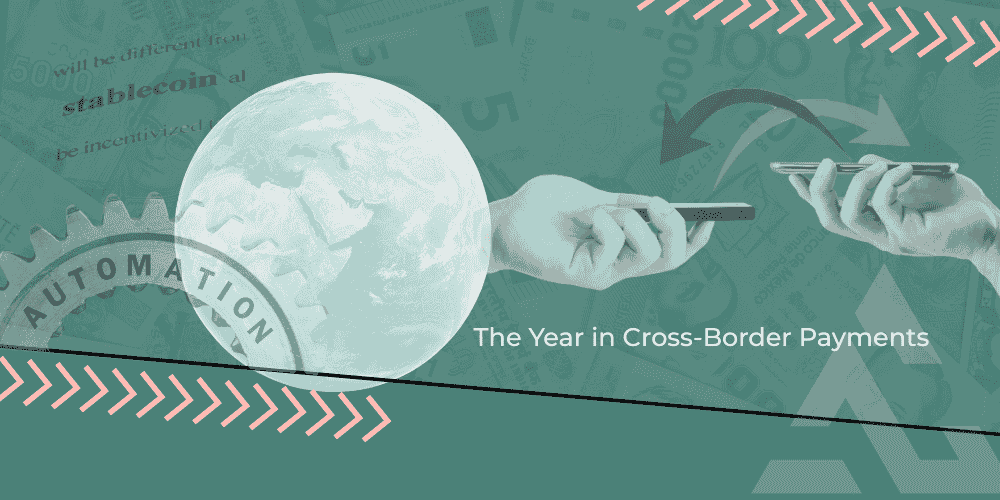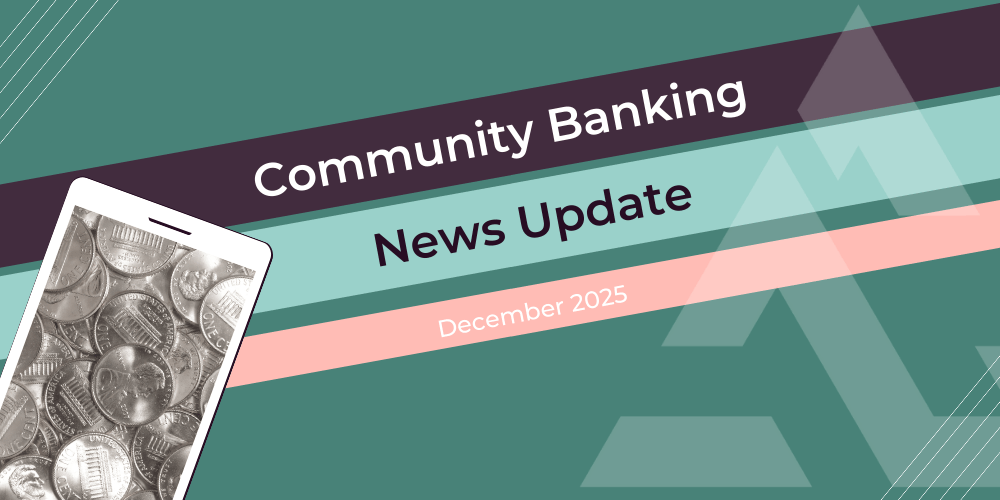The Year in Cross-Border Payments and Correspondent Banking
International wire automation, stablecoins, wallets, and AI reshape global money movement What a pivotal year in cross-border payments. No one...
6 min read
 Daisy Lin, Head of Marketing, Acceleron
:
9/5/24 11:12 AM
Daisy Lin, Head of Marketing, Acceleron
:
9/5/24 11:12 AM

Welcome to the latest edition of Community Banking News Update. Every first week of the month, we will curate a roundup of the most significant and interesting news stories relevant to community banks and explore why they matter.
Stay informed and sign up for our newsletter to receive the latest community banking news updates directly in your inbox. We’ll only send the essential information you need.
The FDIC has proposed stricter regulations on brokered deposits, commonly known as "hot money," which are used by banks to quickly boost their capital in times of need. These deposits, typically provided to banks by brokers seeking high returns, are criticized for their volatility and tendency to leave banks vulnerable during financial stress. The FDIC is concerned that banks relying heavily on brokered deposits could face significant instability if those funds are withdrawn suddenly, potentially leading to bank failures and higher costs for the Deposit Insurance Fund.
The new proposal seeks to label more third parties as deposit brokers, effectively reversing a 2020 rule that allowed weaker banks easier access to these funds. The FDIC points to recent bank failures, such as Voyager Digital and First Republic Bank, as examples of how reliance on brokered deposits can exacerbate financial difficulties. Through tighter oversight of brokered deposits, the FDIC aims to prevent banks from relying on this risky funding source, thereby promoting greater stability within the banking system. The proposal will be open for public comment for a 60-day period.
For community banks, these proposed regulations could have far-reaching implications. The stricter rules on brokered deposits may limit their ability to secure quick funding during financial stress, potentially straining their liquidity management. As community banks often rely on brokered deposits to bridge gaps in funding, these changes could force them to seek more traditional and stable sources of capital. This regulatory shift could drive community banks to rethink their funding strategies, underscoring the importance of securing new sources of deposits through non-interest income.
Read our article about the importance of non-interest income and the opportunities in international payments on the Acceleron blog:
JPMorgan Chase is significantly expanding its branch network in smaller cities and towns across middle America. Chairman and CEO Jamie Dimon is launching his 14th annual bus tour in Iowa, where the bank plans to open 25 new branches by 2030. The expansion reflects JPMorgan’s strategy to increase its footprint, even as other banks scale back on physical locations due to rising costs and the shift towards digital banking.
JPMorgan's dominant position in the banking industry allows it to invest in brick-and-mortar branches while competitors are closing locations. By prioritizing locations based on population growth, small business presence, and community development opportunities, JPMorgan aims to make inroads in areas traditionally served by community banks to capture a larger share of the deposit market.
As big banks like JPMorgan Chase expand their footprint in small towns, community banks face a critical need to differentiate themselves. To stay competitive, they must leverage their unique strengths, such as deep local knowledge and personalized service. What’s more, exploring new technology and automation are key to staying nimble. By adopting modern digital tools and automating processes, community banks can enhance efficiency, offer better banking experiences, and compete with the sophisticated services of larger institutions. Balancing these advancements with their community-focused approach may be essential to surviving and thriving in this competitive environment.
Read our article about leveraging automation and new technologies to streamline international payment processes on the Acceleron blog.
.png)
Capital One and Citi have announced plans to connect to the Federal Reserve's instant payment system, FedNow, in the near future. While FedNow has already onboarded around 900 financial institutions since its launch last July, these two major banks are part of a small group of large financial institutions that have yet to join. Their participation would add to the growing network of banks using FedNow to clear payments within seconds, a significant advancement in the U.S. payments system that aims to enhance real-time transaction capabilities nationwide.
This move underscores the broader industry shift toward faster payment solutions, although some major banks, like Bank of America and PNC, remain hesitant about joining FedNow. The system was developed partly to provide smaller U.S. financial institutions with an alternative to The Clearing House's Real-Time Payments (RTP) network, which has seen slower adoption among banks wary of its control by larger competitors. Capital One and Citi's participation could signal increased momentum for FedNow as it seeks to expand its reach across the U.S. financial sector.
The decision by Capital One and Citi to join FedNow is significant for community banks as it highlights the growing importance of instant payment systems in the U.S. financial landscape. As more large banks adopt FedNow, community banks may face increased pressure to offer similar real-time payment capabilities to stay competitive. Joining FedNow can equip community banks with the necessary tools to enhance their payment services, meet the growing demand for faster transactions, and compete effectively with larger institutions already adopting instant payments. However, it’s equally important for these banks to prioritize fraud prevention and ensure they have the resources to protect against potential risks. Making a well-informed decision to adopt FedNow not only positions community banks to stay competitive but also to safeguard their operations in this rapidly evolving financial landscape.
The Federal Reserve is working to bolster fraud prevention measures for its FedNow instant payments system, addressing concerns that faster payments could lead to quicker fraud. As FedNow celebrates its first year, the central bank is focused on developing additional tools to help financial institutions manage risks, including features like value limits, velocity thresholds, and guardrails to reject potentially fraudulent transactions. The Fed also plans to introduce new features specifically for correspondent banks, aiding them in liquidity management and enhancing overall system security. These enhancements aim to support the financial institutions already using FedNow and encourage broader adoption among the U.S.'s 10,000 banks and credit unions.
Chief FedNow Executive Nick Stanescu highlighted the importance of these new tools during a recent podcast, emphasizing the ongoing effort to provide banks with robust guardrails against fraud. With FedNow capable of clearing payments in seconds, he says the Fed is committed to ensuring that security measures keep pace with the speed of transactions.
The FedNow system's enhanced fraud prevention tools are particularly crucial for community banks, which often have fewer resources to combat sophisticated fraud schemes compared to larger institutions. By adopting these new features, community banks can better protect their customers and manage risks associated with instant payments. Additionally, the tailored support for correspondent banks may ease the way for even smaller financial institutions can participate in FedNow confidently, knowing they have robust safeguards in place. These measures start to level the playing field for community banks in their effort to offer competitive, secure real-time payment services.
Regional bank mergers and acquisitions (M&A) have surged this year, with 38 deals announced so far compared to 29 during the same period in 2023, according to data from Dealogic. Despite this increase in activity, the cumulative deal value has dropped significantly, totaling $9.1 billion compared to $20.9 billion last year. Notable transactions include UMB Financial’s $2 billion purchase of Heartland Financial and SouthState’s acquisition of Independent Bank for a similar amount, alongside Renasant's plan to buy The First for $1.2 billion and WesBanco's $959 million acquisition of Premier Financial.
This wave of M&A activity highlights a strategic shift among regional banks as they seek to offset increased regulatory and technology costs by spreading them across larger platforms. However, the landscape is not without challenges. Lengthy regulatory approval processes and heightened scrutiny from federal agencies are causing some bank executives to approach potential deals with caution. As the year progresses, the Federal Reserve's actions on interest rates and new regulatory proposals could further influence the pace and nature of M&A in the banking sector.
The surge in regional bank mergers poses both challenges and opportunities for community banks. As regional players consolidate, they may gain competitive advantages through increased resources and broader service offerings, potentially drawing customers away from smaller institutions. However, this environment also opens doors for community banks to differentiate themselves by focusing on personalized customer service, local expertise, and niche markets. Finding new sources of revenue through technology and automation can help too.
In a significant development for the U.S. economy, a key inflation measure closely monitored by the Federal Reserve remained subdued in July, further solidifying a trend of cooling price increases. According to the Commerce Department, prices rose by just 0.2% from June to July, with year-over-year inflation steady at 2.5%, only slightly above the Fed’s 2% target. This continued deceleration in inflation is expected to pave the way for the Federal Reserve to initiate its first interest rate cut in 4 1/2 years during its upcoming September meeting. Economists predict a reduction of at least a quarter-point from the current 5.3% benchmark rate, potentially easing borrowing costs for consumers and businesses alike.
Despite the positive inflation trend, economic concerns persist. Consumer spending outpaced income growth in July, leading to a drop in the savings rate to 2.9%, its lowest level since early in the pandemic. This decline suggests that spending may soon slow, potentially impacting economic growth in the coming months. Fed Chair Jerome Powell also emphasized the need to prevent further job market deterioration, as the unemployment rate has risen for four consecutive months.
For community banks, the prospect of lower interest rates could have significant implications. Rate cuts would reduce borrowing costs, potentially boosting demand for loans, including mortgages, auto loans, and business credit. However, lower rates might also compress interest margins, challenging banks to maintain profitability in the short term. Community banks will need to carefully manage their loan portfolios and explore other revenue streams to adapt to the changing rate environment. Additionally, with consumer spending remaining strong, community banks may see increased activity but must also prepare for potential shifts if economic growth slows.
Acceleron builds cutting-edge software that allows community banks and credit unions to conduct international payment transactions profitably through a foreign exchange (FX) marketplace. Serving over 200 financial institutions and facilitating more than $1 billion in international payments annually, Acceleron helps small banks generate non-interest income and compete more effectively with high-fee big banks. Our solutions integrate seamlessly with top payments platforms, ensuring quick implementation and smooth operation.
Explore how Acceleron's FX Marketplace can enhance your bank's resilience and profitability. Contact us now.

International wire automation, stablecoins, wallets, and AI reshape global money movement What a pivotal year in cross-border payments. No one...

New rules, no pennies, and next-generation rails: this month’s biggest banking news As the year winds down, the industry isn’t slowing. The Fed is...

The SVP, Head of Business Development for Service Providers at The Clearing House talks instant payments, bourbon, and fraud. When you talk to...